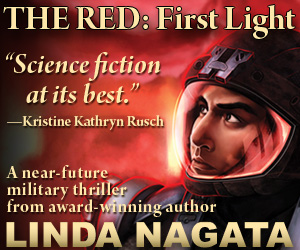 Over the past few months, many of you have asked Whatever happened to The Red: Trials? This was the sequel to my 2013 self-published novel The Red: First Light and had been scheduled to publish last May. It has not been published (yet) and now I’m finally free to say why. So here’s the story:
Over the past few months, many of you have asked Whatever happened to The Red: Trials? This was the sequel to my 2013 self-published novel The Red: First Light and had been scheduled to publish last May. It has not been published (yet) and now I’m finally free to say why. So here’s the story:
Last spring I got to talking with my long-time agent. Naturally, we hadn’t had much business with each other since I started self-publishing, but one thing led to another, he read The Red: First Light, loved it, and asked if he could auction that book along with Trials, and an as-yet-unwritten final novel in the trilogy.
I thought about it. I talked the idea over with my husband. I added up what First Light had already earned, and I estimated what I might expect to earn in the next year or two. The finances convinced me: an auction was worth trying, so long as it was a walk-away deal. My agent agreed: if I didn’t get an offer I liked, I would continue on my own.
In fact, I planned to continue as before, publishing The Red: Trials according to the original schedule, but during the auction period I was asked to hold off on releasing it. On reflection that seemed a reasonable request, so I agreed. It was a gamble though, because I was giving up a wonderful publicity opportunity. Fortunately, the gamble proved worthwhile.
The big news: Now that the contract has been signed, I am very pleased to announce that The Red series has been acquired by Joe Monti, Executive Editor at Saga Press, which is an imprint of Simon & Schuster. Joe has been very enthusiastic, and I am all approving of the marketing direction he has in mind. I see this deal as a fantastic opportunity to get my name out in the world and more widely known, which should help push sales of my backlist, which might lead to me earning a reasonable income from writing for, essentially, the first time ever. My husband has always been the primary breadwinner around here, so the opportunity to give back to him means a lot to me.
For now, The Red: First Light has been withdrawn from sale pending the release of the forthcoming Saga Press edition.
I’m not turning my back on self-publishing, but after almost five years at this game, it felt like the time had come to try something different. I think that’s the key, to keep trying new things, and this is the right thing for me, and for my family, at this time.
I do have one regret: I know I’m disappointing several of you who’ve let me know that you’re eagerly awaiting Trials. Be assured that it will be published, just a little later than initially planned and under the slightly modified title The Trials. I hope you’ll stick with me until then. And I do want to thank all the readers and reviewers who supported the original edition, and made this step forward possible for me.
I’ll be sending out my newsletter at rare intervals, as always, so if you’d like a notification of the publication date of the Saga Press edition of the series—or occasional news on my other books and writing—please sign up using the form in the right column of this page.
And in the meantime, I have a lot of other novels! If you haven’t read them yet, check out Memory or The Bohr Maker. Both are good places to start if you’d like to get to know my work.









